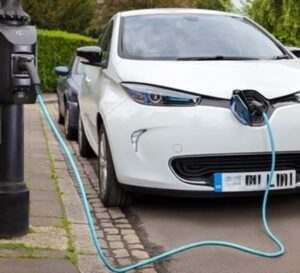Just before lockdown, I and my colleagues Matt Cook and Miguel Valdez were involved in a research bid in response to an Innovate UK call to address the problem of on-street charging for electric vehicles. EV take-up had been predominantly by people who could charge their cars in their drive or garage. For others, charging their cars is more of a challenge. Some, who had to park in the street, trailed their charging leads from their house, a far from safe procedure.
Our consortium won funding for a demonstrator project that explored three key specifications that a design:
- Served the needs of those without off-street parking
- Addressed the street clutter issue of wired charging
- Was affordable by users
The consortium was led by the commercial company Char.gy. This company had developed an elegant lamppost EV charger design which exploited the fact that the switch to LED lighting left surplus power available at lampposts. A charging point could be connected to the lamppost column using this surplus power supply, incorporating software to sell this on to motorists, while paying the local authority for the power used. This only delivers about 4KW, but that is fine for an overnight charge, which is the market envisaged. Since the local authority buys electricity at a cheap bulk rate, there is ample scope for the user to buy electricity at a reasonable price even with the company and local authority getting a cut.

This neat product and service system design was the basis for our project, which explored developing this approach into a wireless charging system. To cut a long development story short, the product design proved viable and in our trials users really liked the wireless inductive charging. However, the extra cost of installing the inductive charging system into a road surface and the kit needed on a user’s car was economically problematic.
In the meantime, a whole range of designs have emerged seeking to address the EV charging market. These range from high powered fast chargers at motorway service stations to ultra-fast charging points appearing at existing local service stations, down to designs to allow people to safely charge their cars through installing simple cross-pavement conduits between their house and the kerbside. The designs using a household’s electricity supply tap into the cheapest cost electricity (as little as 5p a KW on a special overnight EV tariff). The designs avoiding expensive new power supplies, such as the lamppost chargers, offer the next cheapest electricity. But the high-powered systems delivering up to 300KW or more, and able to charge an EV in 10 minutes, require considerable investment in new high-powered electricity supplies and these costs are reflected in the cost to the user. To charge a car at a service station using this kit, costs around 75p a KW – making it more expensive than petrol!
And so, we come to our designerly dance analogy. On one side of the dance floor are the various EV charging designs, from plug-in on a house drive, pavement conduits and lamppost chargers, through to the faster public chargers, those at shops and workplaces, with others at service stations delivering 150 – 300KW. All these designs offer different benefits and different costs to the user, which brings us to the dance partners on the other side of the floor.
The dance used to be so easy and the steps well known. Petrol and diesel cars were filled up at a service station and that was it. One market and one design to satisfy it. But now the dance is much more complex and each side are meandering around trying to sort out if they can get on with each other. Some of the dancers seem very confused and wished they’d stayed away. In design studies, this is something that is well-known at times of innovation. The multiplicity of bicycle designs in the late 19th century is a classic case. That led to the emergence of a dominant design – the safety bicycle. With EV charging designs this seems unlikely as the different markets involve contrasting specifications. EV charging is unlikely to settle down to a single dominant design as it did for petrol service stations. A split between slow and fast charging designs seems inevitable as the costs providing each are inherently so different. The likelihood is that the designerly dance will have even more players before it simplifies. The danger is that this will confuse motorists and only encourage kickback against the transition to EVs as a whole. Perhaps there is a more proactive role for government in sorting out this muddled dance than funding technology development demonstrations.

Leave a Reply